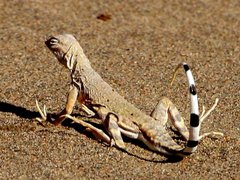Lizard
Lizards are reptiles of the order Squamata, which they share with the snakes (Ophidians). They are usually four-legged, with external ear openings and movable eyelids. Species range in adult length from a few centimeters (some Caribbean geckos) to nearly three meters (Komodo dragons). more...
Some lizard species called "glass snakes" or "glass lizards" have no functional legs, though there are some vestigial skeletal leg structures. They are distinguished from true snakes by the presence of eyelids and ears.
Many lizards can change color in response to their environments or in times of stress. The most familiar example is the chameleon, but more subtle color changes occur in other lizard species as well (most notably the anole, also known as the "house chameleon" or "chamele").
Lizards typically feed on insects or rodents. A few species are omnivorous or herbivorous; a familiar example of the latter is the iguana, which is unable to properly digest animal protein. Until very recently, it was thought that only two lizard species were venomous: the Mexican beaded lizard and the closely-related Gila monster, both of which live in northern Mexico and the southwest United States. However recent research at the University of Melbourne, Australia and Pennsylvania State University has revealed that in fact many lizards in the iguanians and monitor (lizard) families have venom-producing glands. None of these poses much danger to humans, as their poison is introduced slowly by chewing, rather than injected as with poisonous snakes. Nine toxins previously thought to only occur in snakes have been discovered, and a number of previously unseen chemicals as well.
These revelations are prompting calls for a complete overhaul of the classification system for lizard species to form a venom clade. "These papers threaten to radically change our concepts of lizard and snake evolution, and particularly of venom evolution," says Harry Greene, a herpetologist at Cornell University in New York.
Most other lizard species are utterly harmless to humans (most species native to North America, for example, are incapable even of drawing blood with their bites). Only the very largest lizard species pose any threat at all; the Komodo dragon, for example, has been known to attack and kill humans and their livestock. The chief impact of lizards on humans is positive; they are significant predators of pest species; numerous species are prominent in the pet trade; some are eaten as food (for example, iguanas in Central America); and lizard symbology plays important, though rarely predominant roles in some cultures (e.g. Tarrotarro in Australian mythology).
Most lizards lay eggs, though a few species are capable of live birth. Many are also capable of regeneration of lost limbs or tails. A brief courtship and mating season occurs between mid-May and early-June. Twenty days after breeding, the female will lay from 2-21 creamy-white leathery eggs in a burrow beneath a large rock. The young hatch 2-3 months later, averaging 3-4 inches in length.
Lizards in the Scincomorpha family, which include skinks (such as the blue-tailed skink), often have shiny, iridescent scales that appear moist. However, like all other lizards, they are dry-skinned and generally prefer to avoid water (though all lizards are able to swim if needed).
Read more at Wikipedia.org


